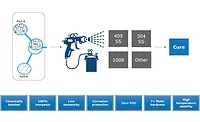A New Approach to Understanding Rheological Additives


With spray application, an optimum compromise has to be found between good vertical flow characteristics (to achieve an adequate film thickness) and good leveling (to obtain a smooth finish). For this reason, in the low-shear range, the viscosity must be set just high enough to prevent vertical flow. At the same time, the viscosity should be kept as low as possible to ensure good leveling. Inappropriate rheological control might be the reason for building curtains or runners that will strongly impact the quality of the resulting surface coating (Figures 2a and 2b).



Adequate effectiveness of modern thickeners is not only extremely important in the field of emulsion paints, but it also plays a major role in industrial coating systems. Unlike emulsion paints, which are usually applied by brush or roller, industrial coatings are normally applied by spraying or dipping. With spray application, an optimum compromise has to be found between good vertical flow characteristics and good leveling. It is logical that in such cases, use is frequently made of an associative thickener that has more of a pseudoplastic rheology profile. In parallel with this, however, it must have a certain efficacy in the high-shear range in order to ensure satisfactory spray application.
With the transition from solventborne to low-solvent or solvent-free coating systems, high demands are made on rheological additives. The trade normally wants the same application properties as they have customarily had with solventborne coatings. In addition, special flow properties1-4 are sometimes specified. Rheological additives, therefore, rank among the most important components in modern coating systems.
Non-Associative Rheological Additives
The thickening effect of the non-associative rheological additives is based primarily on a thickening of the aqueous phase as a result of polymer chain entanglement. There is virtually no interaction with other components of the coating system. Whereas the water-binding behavior of the polymer (e.g. water retention by cellulose ethers) prevents the undesirable effect of the water disappearing into highly absorbent substrates, it does create the risk that the dispersed particles are displaced from the aqueous phase, leading to flocculation due to volume restriction. This flocculation can result not only in a deterioration of the gloss, but it can also have a negative effect on the corrosion resistance of the coating system.5Associative Thickeners
With associative thickeners, this effect occurs only in rare cases. The mode of action of these additives is primarily based on the interaction (association) of the hydrophobic components of the thickener molecule with components of the coatings such as latex particles, pigments and extenders. The hydrophilic segments of the thickener remain in the aqueous phase. As a result of the interaction, a three-dimensional reversible physical crosslinking occurs in the dispersion, which has a major influence on the flow properties of such a system.
By varying the chemical structure of the rheological additive, the flow properties of modern coating systems can be adapted to the respective requirements.4,6-10 For example, highly effective polyurethane thickeners can be specifically synthesized for emulsion paints (for roller or brush application), which are especially suitable for the high shear rates typical of this kind of application. Apart from this, rheological additives must be such that, in combination with other thickeners (for example, with the cellulose derivatives used for the low-shear sector), they can create an overall rheology profile that combines adequate storage stability and good vertical flow/leveling characteristics with optimum application properties.

Special Aspects When Using Associative Thickeners in Aqueous Systems
Water-thinnable coatings are complex, multi-component systems whose application properties depend not only on the proportion and properties of the individual components, but also on their respective interactions. This becomes particularly evident when adjusting the flow properties of aqueous coating systems because the flow requirements can vary considerably according to the particular application.The flow behavior of such systems is affected in particular by the following factors:
-
•Disperse phase (volume content, particle size, particle size distribution, degree of dispersion, interaction of the individual particles);
•Medium (water, co-solvents);
•Temperature;
•pH;
•Additives.
One of the key factors affecting the flow behavior of coating systems is the interaction of the individual particles. With regard to pigments and extenders, instability of the coating can be caused by coagulation, which is due to the effects of surface charging. In addition, problems can also arise, for instance, through the interaction of water-insoluble coalescing agents with the polymer particles.
As far as the rheological profile of liquid systems is concerned, we can basically distinguish between three groups (we refer here, above all, to surface coatings) (Figure 6):
- •Newtonian: The viscosity of the system does not depend on the shear gradient applied.
•Dilatant: Viscosity rises with increasing shear (which is normally extremely undesirable in surface coatings).
•Pseudoplastic (non-Newtonian, thixotropic): The viscosity decreases with increasing shear gradient and then, when the external forces decline, returns immediately (non-Newtonian) or with a certain delay (thixotropic) to approximately its original value.
- •Optimum addition of the thickener;
•Salt content of the coating;
•Selection of suitable rheological additives when using combinations of low- and high-shear thickeners;
•Careful adjustment of the pH.

Structure/Rheological Effectiveness of Associative Thickeners
The efficient use of rheological additives presumes a deeper knowledge of the relationship structure/rheological effectiveness of associative thickeners and their interaction with other components in aqueous coating systems.
As the Type A method is limited to the availability of mono isocyanates, it is sometimes more convenient to combine OH-bifunctional polyethers e.g. H-[O-CH2-CH2]x-OH together with diisocyanates OCN NCO and aliphatic alcohols OH

The hydroxyl groups of the polyether compete with the hydroxyl group of the alcohol in the same manner while reacting with the isocyanate groups and, therefore, lead to a statistically determined distribution of polymer chains of type C:

This reaction method also leads to by-products of low molecular weight such as those of type D.


At very low concentrations, the polyurethane thickener can be considered as monomolecular dissolved in the aqueous phase. With increasing concentration of the polyurethane thickener material, a formation of micelles is observed. The corresponding CMC-values (critical micelle concentration) are relatively low.8,12

This behavior can be interpreted as a tendency of the system to reduce the surface energy of the hydrophobic segments in a polar medium by forming micelles, which are concentrated in one phase.
The binder content of a paint or lacquer formulation is also of great importance for the rheological efficiency of an associative thickener. Figure 7 shows the flow curves of two similar emulsion paints with different binder content but containing the same amount of PU-thickener. Formulations with higher solids (binder) are more sensitive against associative thickening effect.

Reversible Formation of Networks Through Micelles and Hydrophobic Segments
What really does happen in a coating system that normally contains several different components such as latex particles, emulsifiers, wetting agents, surfactants, pigments and extenders etc.?In various formulations containing water, wetting agent, pigments (TiO2) and extenders, only a weak rheological effect with associative thickeners is observed. At the same time, when a latex emulsion is added to this mixture, the rheological profile increases substantially. Therefore, it can be concluded that the interaction between latex particles and associative thickeners is mainly responsible for a thickening effect in such a system.
If additional amounts of emulsifier or glycol are added to a ready-for-use coating system, there is often a remarkable decrease in the rheological profile, especially in the low shear range. The reason for this could be a displacement of linking groups of the associative thickener from the surface of a latex particle or pigment through the surfactant.
As for the formation of associative structures, i.e. reversible networks, two possible versions are discussed11 (Figure 8):
- a) Formation of hydrophobic clusters, as well as micelles, through the rheological additive.
b) Association of dispersed particles with the hydrophobic segments of the rheological additive.
Moreover, it is most likely that the dispersed particles in a paint or lacquer formulation have a protective layer, which is normally built up of wetting and dispersion agents. If we assume that the major part of a dispersed particle is blocked with those substances, then it is inevitable that dynamic replacement processes must take place in order to realize a significant association with a PU-thickener and therefore a remarkable thickening effect.
The affinity of both a surfactant and an associative thickener respectively to such a particle surface has a large impact on the rheological efficiency. Therefore, diffusion processes also play an important role in this connection and have to be taken into consideration.
References
1 Prideaux, J. Surf. Coat. Int. 76 (1993) (4), 180-183.
2 Schaller, E.J.; and Sperry, P.R. Handbook of Coatings Additives, Marcel Dekker Inc., New York, Basel, Hong Kong, Vol. 2 (1992), Chap. 4, 105-163.
3 Kaczmarski, J. Ph.; Fernando, R.H.; and Glass, J.E. J. of Coat. Technol. 65 (1993) 818, 39-46.
4 Mavex, T.L. J. of Coat. Technol. 64 (1992) 812, 45-58.
5 Sperry, P.R.; Thibeault, J.C.; and Kostansek, E.C. 11th Proc. Int. Cont. Org. Coat. Sci. Technol., New Paltz, N. Y., 1-11.
6 Bielemann, J.H.; Riesthuis, F.J.J.; and van der Velden, P.M. Polym. Paint Col. J. 176 (June 1986), No. 4169.
7 Naé, H.N.; and Bank, R.H. Rheology 91 (October 1991), 170-178.
8 C. D. Eisenbach et al. Farbe & Lack, 5/2002, S. 44 ff.
9 Nae, H. Polymers Paint Colour J., 183 (4328), 226, 1993.
10 Bielemann, J.H.; Riesthuis, F.J.J.; and v.d. Velden, P.M. Polymer Paint Col. J., 176 (4169), 1986.
11 Hester, R.D.; and Squire, D.R. J. of Coat. Technol., 69 (864), 109, 1997.
12 Pham, Q.T.; Russel, W.B.; Thibeault, J.C.; and Lau, W. Macromolecules 32, 2996-3005, 1999.
Looking for a reprint of this article?
From high-res PDFs to custom plaques, order your copy today!






